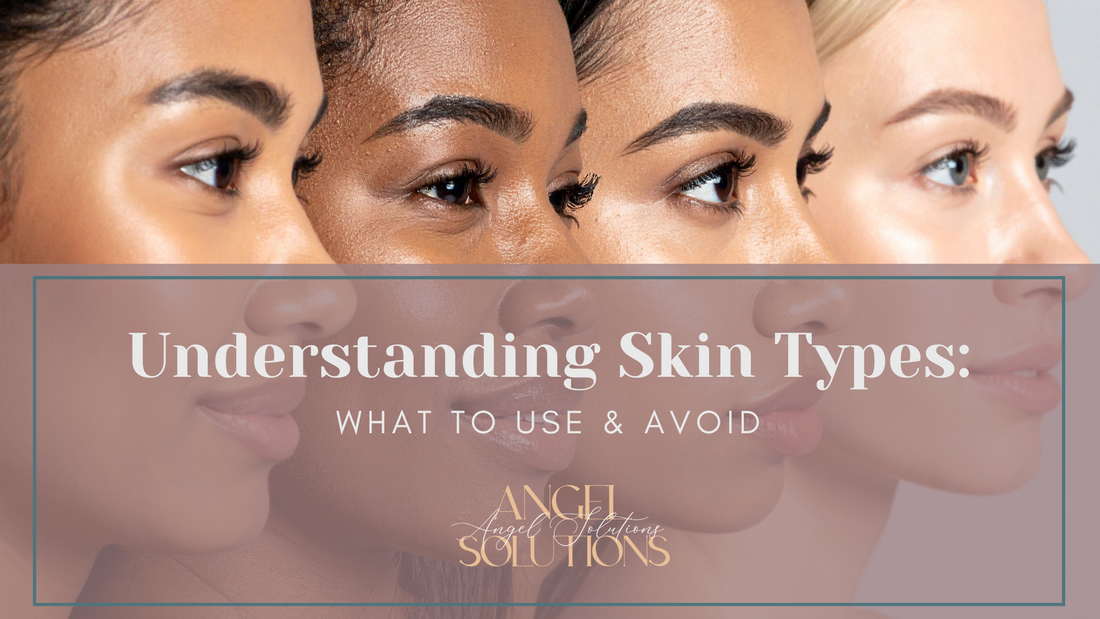
Understanding Skin Types: What to Use & Avoid
Share
Why Knowing Your Skin Type Matters

When it comes to skincare, one size doesn’t fit all. The products that make one person’s skin glow might cause another’s to break out or feel irritated. That’s because your skin type determines how your skin reacts to ingredients, weather changes, and even your daily routine.
If you want healthy, glowing skin, the first step is understanding your skin type — then learning which ingredients will help or harm it.
The 5 Main Skin Types
1. Normal Skin
- Signs: Balanced moisture, few blemishes, smooth texture, minimal sensitivity.
- Best Ingredients: Hyaluronic acid, vitamin C, gentle exfoliants like lactic acid.
- Avoid: Harsh alcohols, overly stripping cleansers.
2. Dry Skin

- Signs: Tight feeling, flaky patches, dull appearance, fine lines more visible.
- Best Ingredients: Shea butter, squalane, ceramides, glycerin, jojoba oil.
- Avoid: Sulfates, drying alcohols (like SD alcohol or denatured alcohol), high concentrations of benzoyl peroxide.
3. Oily Skin

- Signs: Shiny appearance, enlarged pores, prone to blackheads and acne.
- Best Ingredients: Niacinamide, salicylic acid, clay masks, lightweight moisturizers.
- Avoid: Heavy mineral oils, thick occlusive creams, coconut oil (comedogenic for many).
4. Combination Skin
- Signs: Oily in T-zone, dry on cheeks, occasional breakouts and dry patches.
- Best Ingredients: Balancing ingredients like green tea extract, hyaluronic acid, aloe vera.
- Avoid: Harsh scrubs, products that over-dry or over-moisturize.
5. Sensitive Skin

- Signs: Easily irritated, redness, stinging or burning sensations.
- Best Ingredients: Chamomile, calendula, oat extract, fragrance-free formulas.
- Avoid: Synthetic fragrance, harsh acids, strong retinoids, essential oils that cause reactions.
Common Irritants to Watch For
No matter your skin type, there are some ingredients that can cause irritation or breakouts, especially in high concentrations:
- Artificial fragrance
- Parabens (controversial preservative)
- Formaldehyde-releasing preservatives (like DMDM hydantoin)
- High levels of denatured alcohol
- Harsh physical exfoliants
How to Check If an Ingredient is Good or Bad for Your Skin
Even if a product is labeled “natural” or “dermatologist-tested,” it’s important to verify ingredients yourself. Here are free online resources that can help:
- INCI Decoder – Breaks down product ingredient lists in plain language.
- EWG Skin Deep – Ranks ingredient safety and highlights possible irritants.
- CosDNA – Checks for comedogenic (pore-clogging) and irritating ingredients.
- Paula’s Choice Ingredient Dictionary – Explains benefits and potential drawbacks of skincare ingredients.
Tips for Choosing the Right Products
- Always patch test new products before full use.
- Start with one new product at a time to identify reactions easily.
- Adjust your routine seasonally — skin needs change with weather.
- Keep your routine simple — more products don’t always mean better results.
Final Thoughts
Understanding your skin type is the foundation of a healthy skincare routine. By knowing what to use — and what to avoid — you’ll save time, money, and frustration. Use ingredient-checking resources before buying, and your skin will thank you with a healthy, radiant glow.
